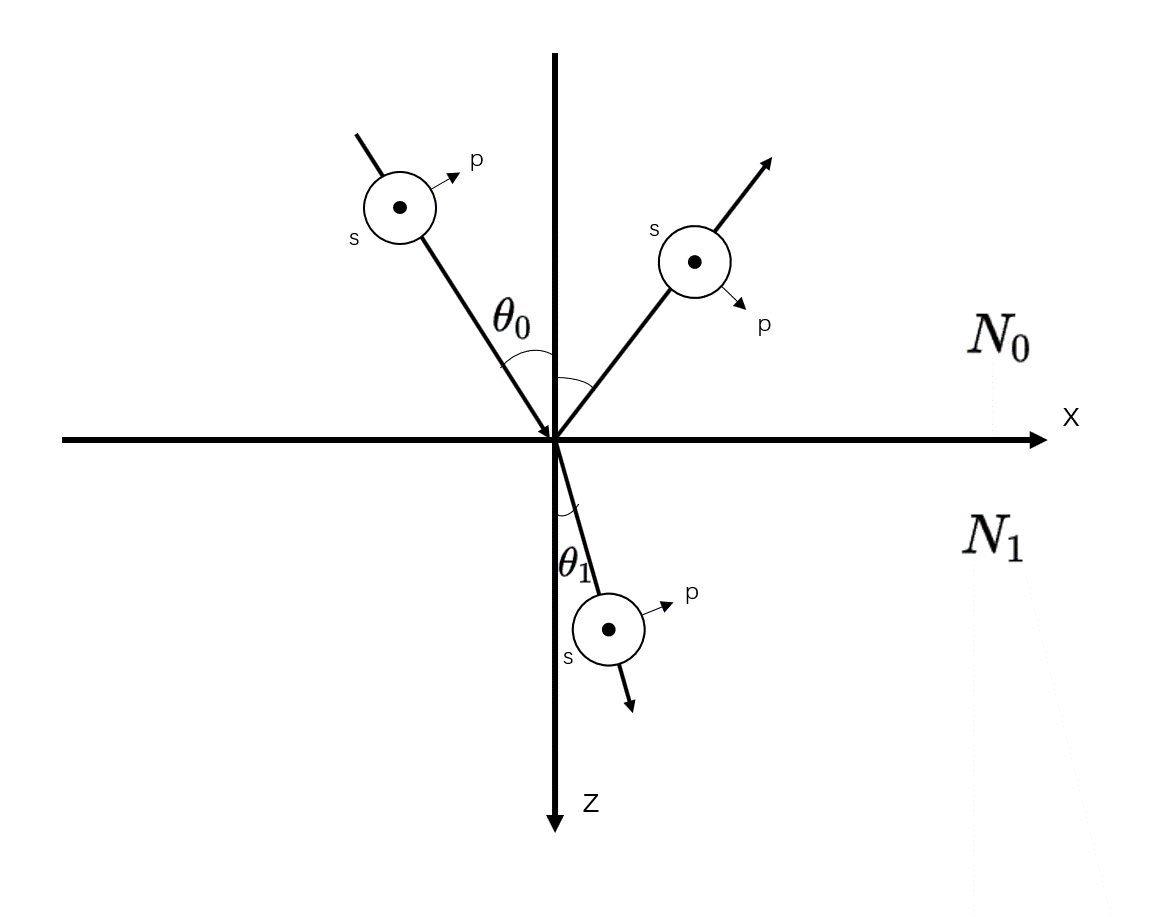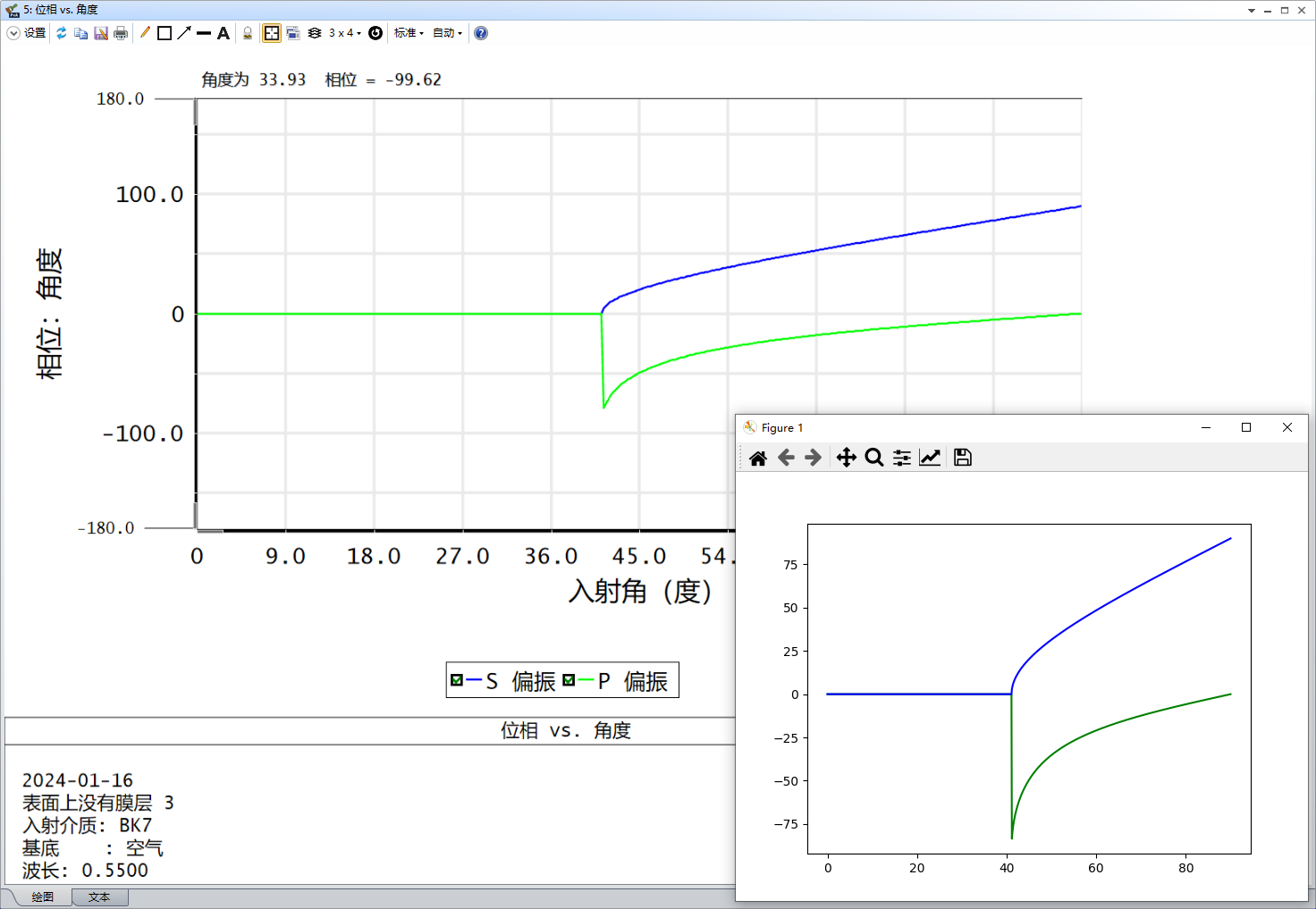光学薄膜特性理论计算1-菲涅尔公式
摘要
光在界面的传播是薄膜理论的基础,本文从麦克斯韦方程组出发推导菲涅尔公式。
1.折射率与光学导纳[1]
麦克斯韦方程组如下
\[ \begin{align} % Gauss's law for electricity \nabla \cdot \mathbf{D} &= \rho \nonumber \\ % Gauss's law for magnetism \nabla \cdot \mathbf{B} &= 0 \nonumber\\ % Faraday's law of electromagnetic induction \nabla \times \mathbf{E} &= -\frac{\partial \mathbf{B}}{\partial t} \nonumber\\ % Ampère's circuital law with Maxwell's addition \nabla \times \mathbf{H} &= \mathbf{J} + \frac{\partial \mathbf{D}}{\partial t} \nonumber \end{align} \]
将\(D = \varepsilon E\) , \(J = \sigma E\)代入麦克斯韦方程组的安培环路定律可得
\[ \nabla \times H = \varepsilon \frac{\partial E}{\partial t} + \sigma E \tag{1-1} \]
对法拉第电感定律两边取旋度并代入(1-1)有
\[ \nabla \times \nabla \times E = - \mu \frac{\partial (\nabla \times H)}{\partial t} = - \mu \frac{\partial }{\partial t}(\varepsilon \frac{\partial E}{\partial t} + \sigma E \tag{1-2}) \]
运用矢量恒等式\(\nabla \times \nabla \times E = \nabla (\nabla\cdot E)-\nabla^2E\)在无电荷的均匀空间(根据高斯定理\(\nabla \cdot \mathbf{D} = 0\)),上式可以化简为
\[ \nabla^2E = \mu \varepsilon \frac{\partial^2 E}{\partial^2 t} + \mu \sigma \frac{\partial E}{\partial t} \tag{1-3} \]
如果介质不导电,即\(\sigma=0\),式(1-3)变为
\[ \nabla^2E = \mu \varepsilon \frac{\partial^2 E}{\partial^2 t} \tag{1-4} \]
通过求解微分方程,在不导电的均匀介质中,沿x正方向行进的电磁波的表达式可以写成
\[ E = E_0 \exp[i\omega (t-\frac{x}{v})]\tag{1-5} \]
其中\(v=1/\sqrt{\mu \varepsilon}\)是在介质中的传播速度,\(\omega\)是角频率。电池波在真空中传播的速度和在不导电均匀介质中的速度比值,被称为介质的折射率,公式如下:
\[ n = \frac{c}{v}=\frac{\sqrt{\varepsilon \mu}}{\sqrt{\varepsilon_0 \mu_0}} = \sqrt{\varepsilon_r \mu_r}\tag{1-6} \]
在光频率下,光学材料的磁导率可以近似认为是1,所以有\(n=\sqrt{\varepsilon_r}\)
式(1-5)可以被认为是式(1-3)的一个特解,对于金属介质(\(\sigma \ne 0\)),将(1-5)回代,得到
\[ \frac{1}{v^2} = \varepsilon \mu - i\frac{\sigma \mu }{\omega} \tag{1-7} \]
则对于金属介质的折射率有
\[ N^2 = \frac{c^2}{v^2} = (\varepsilon \mu - i\frac{\sigma \mu }{\omega})/\varepsilon_0 \mu_0 \tag{1-8} \]
可知金属的折射率为复数,记作\(N = n - ik\),回代入式(1-5)得
\[ E = E_0 \exp{(-\frac{2\pi k x}{\lambda })}\exp{ \left [ i(\omega t - \frac{2\pi n x}{\lambda}) \right ] } \]
说明对于金属折射率的虚部会让电磁波发生指数级衰减,所以k又被称为吸收系数。
同理,磁场也可以写做波函数的形式,磁场和电场的表达式如下:
\[ \mathbf{H} = H_0 \exp{ \left [ i(\omega t - \frac{2\pi N }{\lambda}) \mathbf{S_0} \cdot \mathbf{r} \right ] } \]
\[ \mathbf{E} = E_0 \exp{ \left [ i(\omega t - \frac{2\pi N }{\lambda}) \mathbf{S_0} \cdot \mathbf{r} \right ] } \]
其中\(\mathbf{S_0}\)是平面波传播方向的单位矢量,\(\mathbf{r}\)是坐标矢径。
对于\(\nabla \times H = -i\frac{2\pi N}{\lambda}(\mathbf{S_0} \times \mathbf{H})\)带入麦克斯韦方程组得
\[ \mathbf{S_0} \times \mathbf{H} = -\frac{N\sqrt{\varepsilon _0/\mu_0} }{\mu_r} \mathbf{E} \]
\[ \frac{N\sqrt{\varepsilon _0/\mu_0} }{\mu_r} \mathbf{S_0} \times \mathbf{E} = \mathbf{H} \]
上两式说明,电场和磁场是相互垂直的,而且都与传播方向垂直,且符合右手螺旋法则。对于传播过程中,E和H不但相互垂直,且数值间也存在一定比值。
\[ Y = \frac{\left | \mathbf{H} \right | }{\left | \mathbf{S_0 \times E} \right | } = \frac{N\sqrt{\varepsilon _0 / \mu_0}}{\mu_r} \]
Y被称为介质的光学导纳,其中磁导率\(\mu_r\)通常接近于1,若以自由空间导纳\(\sqrt{\varepsilon _0 / \mu_0}\)为单位,则光学导纳与折射率相等。
2.折射反射定律
根据电磁场的边界条件在界面处E和H的切向分量是连续的,有
\[ E_t^i + E_t^r = E_t^t \]
\[ H_t^i + H_t^r = H_t^t \]

按图中所示,光线在xz平面传播,以\(\theta_0\)的角度入射到界面,界面为\(z=0\)平面。其入射光相位因子为
\[ \exp{\left \{ i\left [ \omega _i t - \frac{2\pi N_0}{\lambda} \left ( \sin\theta_0 x + \cos \theta_0 z\right ) \right ] \right \} } \]
设反射光和透射光的相位分别为
\[ \exp{\left \{ i\left [ \omega _i t - \frac{2\pi N_0}{\lambda} \left ( \alpha_r x +\beta_r y+ \gamma_r z\right ) \right ] \right \} } \]
\[ \exp{\left \{ i\left [ \omega _i t - \frac{2\pi N_1}{\lambda} \left ( \alpha_t x +\beta_t y+ \gamma_t z\right ) \right ] \right \} } \]
要满足边界条件,界面上的相位因子必须相等。所以有\(\beta_r = \beta_t = 0\)、\(N_0 \alpha_i = N_0 \alpha_r = N_1 \alpha_t\)
可以得出反射和折射定律
\[ \theta_0 = \theta_r \]
\[ N_0 \sin \theta_0 = N_1 \sin \theta_t \]
3.菲涅尔公式
3.1 垂直入射情况
为进一步研究反射光和入射光振幅和相位的变化关系,我们先假设光是垂直入射界面的。
对于垂直入射界面的光,显然有E和H都是平行于界面,有 \[ H_1 = H_t , E_1 = E_t \]
又根据边界条件有
\[ E_1 = E_0^+ + E_0^- \]
\[ H_1 = H_0^+ + H_0^- \]
其中下标0和1代表界面的两边,上标+代表正向传播,-代表反向传播。结合上式有
\[ H_1 = N_1(S_0 \times E_1) = N_0(S_0 \times E_0^+ - S_0 \times E^-_0) \]
即
\[ N_1 E_1 = N_0 (E_0^+ - E_0^-) \]
化简可得反射系数和透射系数
\[ r = \frac{E_0^-}{E_0^+} = \frac{N_0-N_1}{N_0+N_1} \]
\[ t = \frac{E_1}{E_0^+} = \frac{2N_0}{N_0 + N_1} \]
3.2 倾斜入射情况
下面考虑倾斜入射的情况。我们将入射的电磁波分解为,电场垂直反射面(s光)和平行反射面(p光)振动的两种状态。

为方便定义切向分量,现引入有效导纳的概念
\[ \eta = H_t^+ / (S_0 \times E_t^+) \]
对于p光(TM波),磁场H垂直于入射面,与界面平行,因此\(H = H_t\),而电场\(E=Ecos \theta\)
\[ H_t = H = N(S_0 \times E) = N(r_0 \times E_t/cos\theta) = \frac{N}{cos\theta}(r_0 \times E_t) \]
所以对于p光有\(\eta_p = N/cos \theta\),同理对于s光有\(\eta_s = Ncos \theta\)
对菲涅尔反射系数可以写作
\[ r_p = \frac{\eta_{0p}-\eta_{1p}}{\eta_{0p}+\eta_{1p}} = \frac{N_0cos\theta_1 - N_1 cos\theta_0}{N_0cos\theta_1 + N_1 cos\theta_0} \]
\[ r_s = \frac{\eta_{0s}-\eta_{1s}}{\eta_{0s}+\eta_{1s}} = \frac{N_0cos\theta_0 - N_1 cos\theta_1}{N_0cos\theta_0 + N_1 cos\theta_1} \]
对于透射系数可以写作
\[ t_p = \frac{2N_0cos\theta_0}{N_0cos\theta_1+N_1cos\theta_0} \]
\[ t_s = \frac{2N_0cos\theta_0}{N_0cos\theta_0 + N_1cos\theta_1} \]
反射率为
\[ R = r^2 \]
透射率为
\[ T = \frac{N_1cos\theta_1}{N_0cos\theta_0}|t^2| \]
该公式对复折射率介质也同样成立。
给出计算代码如下,其中函数公式中符号相反只影响相位,并不影响透射和反射率。
1 | import matplotlib.pyplot as plt |
3.3 全反射情况
这里只给出相位公式,公式来着参考资料[1]
\[ \tan \frac{1}{2}\varphi _s = \frac{(\sin^2\theta_0 - n_1^2/n_0^2)^{1/2}}{\cos \theta_0} \]
\[ \tan \frac{1}{2}\varphi _p = \frac{n_1^2/n_0^2 \cdot \cos\theta_0}{(\sin^2\theta_0 - n_1^2/n_0^2)^{1/2}} \]
但在使用zemax仿真时,发现相位不需要乘2数值才是匹配的,源码和仿真结果如下
1 | import matplotlib.pyplot as plt |

参考资料
[1] 唐晋发.现代光学薄膜技术.浙江大学出版社.2006年